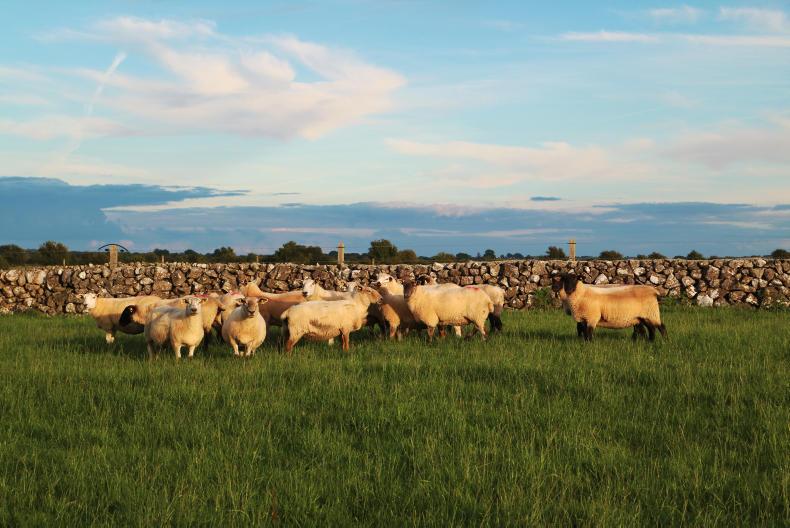Getting young farmers involved in sheep enterprises has been a challenge in recent years, with a high percentage of new entrants favouring dairying.
There are, however, pockets of the country where interest in sheep farming remains the dominant enterprise. South Roscommon is one of these with areas such as Athleague, Four Roads, Dysart and the extended hinterland still possessing a high population of active sheep farmers.
This was reflected in the attendance of about 150 producers at a sheep seminar run last week by Nutrias and Bimeda on the Kelly farm in Turrock, Dysart, Ballinasloe, Co Roscommon.
The farm is operated by Mattie John Kelly, his father Mattie and sister Margaret, with Mattie John joining the running of the farm on a full-time basis following the completion of the Green Cert in 2011.
This kick-started a drive to increase the sheep enterprise, with ewe numbers rising annually from 200 ewes and 70 ewe lambs in 2009 to 420 ewes and 80 ewe lambs (from a total of 100) targeted for lambing in spring 2017.
The increase in ewe numbers has been achieved through a combination of increasing the farm’s stocking rate and also access to rented and leased land.
The stocking rate now stands at close to four ewes per acre, with the sheep enterprise also run in a mixed grazing system alongside a 20-cow suckler herd. The suckler production system involves finishing bulls at 18 to 20 months of age, with heifers sold as forward stores.
Breeding preparations
At the walk, there was a strong focus on preparations for breeding, a critical focal point in the farm’s diary. Ewes are being handled on a regular basis and managed in accordance with their body condition score and the aim of having ewes on a rising plane of nutrition and hitting BCS 3.5 at mating.
The first batch of ewes are currently being flushed and will be put to the ram on 5 September, to give a target commencement date for lambing of 1 February.
“Lambing is more fragmented than we would like, with ewes mated to lamb in three batches next spring: of 150 on 1 February; 150 on 1 March; 120 from St Patrick’s Day, followed by the ewe lambs in early April,” Mattie John explains.
“It’s drawn out, but there is only housing and lambing facilities available for about 160 ewes at any one time, and our preference is to lamb indoors. We plan to invest in more animal housing to allow a more straightforward lambing period in the coming years.”
There has also been a focus, while building numbers, to incorporate more prolific genetics. The foundation genetics in the flock are Suffolk x Cheviot cross and, in recent years, Belclare and Bluefaced Leicester breeding has been added to lift the litter size.
“We are trying to find the best balance between increasing our litter size and breeding a ewe and ewe lamb that has good output without going excessive on litter size, retains a good frame and size and is a good seller as a ewe lamb.
“The Belclare cross is a smaller ewe than is ideally sought after around south Roscommon. To keep a bit of size, we are only using Belclare in the first cross on Suffolk or Suffolk-cross ewes and breeding these ewes back to Suffolk rams.
In recent years, we have targeted Bluefaced Leicester breeding to add back size to some smaller ewes. The Bluefaced Leicester has been culled due to age, and we are going to experiment with Texel this year across some of the ewes that could do with regaining a bit more frame.
“Charollais rams are mated with ewe lambs and hoggets for ease of lambing with Charollais cross lambs slaughtered or sold as stores,” says Mattie John.
The lambing percentage has gradually lifted, and last year hit 1.9 lambs per ewe put to the ram (excludes ewes lambs). Having limited lambing facilities, Mattie John would like to keep the lambing percentage between this level and two lambs per ewe, with an emphasis on getting ewes and lambs out to grass immediately.
Selecting replacements
There has also always been a strong focus on retaining good productive ewes and a young flock. “Dad would have always operated a young flock, bringing in a lot of replacements each year and selling second- and third-crop ewes for breeding,” explains Mattie John.
“The age profile in the flock has increased in line with increasing numbers, but we are now in a position again of being able to cull harder and remove poorer breeders. The emphasis on good maternal genetics also means we have a high number of ewe lamb replacements to choose from. We generally select these from the early-lambing flocks to breed as ewe lambs and are lucky to have a good customer base for any surplus ewe lambs,” he says.
Building grass supplies
Grass management is currently aimed at meeting a rising nutritional demand of ewes pre mating, cows with aging spring calves and remaining ewe lambs for breeding and those identified for sale in September.
This is against a backdrop of building a bank of grass for grazing ewes late into the year, with dry free-draining soils on the home block allowing a long grazing season.
A final round of fertiliser is being applied to a percentage of the farm to increase growth rates, while reseeding of an area of land that is being reclaimed is also taking place this week, with a grass-clover seed mix that suits grazing or silage production. To reduce demand and aid building supplies, bulls will be brought indoors for intensive finishing, while lambs that won’t finish on the farm in the immediate weeks ahead may be traded as stores if grass supplies are not building as required.








SHARING OPTIONS